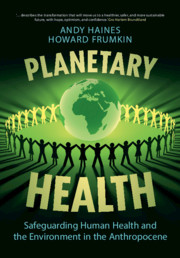Book contents
- Planetary Health
- Reviews
- Planetary Health
- Copyright page
- Contents
- Preface
- Acknowledgements
- 1 Our Changing Planet
- 2 Climate Change
- 3 Pollution, Land Use, Biodiversity, and Health
- 4 Assessing Vulnerability and Risk in the Anthropocene Epoch
- 5 Adaptation and Resilience to Planetary Change
- 6 Addressing Conceptual, Knowledge, and Implementation Challenges
- 7 Health in the Sustainable Development Goals
- 8 Transforming Energy and Industry: Towards a Net-Zero Circular Economy for Health
- 9 Sustaining Urban Health in the Anthropocene Epoch
- 10 Food Systems and Land Use
- 11 The Role of Health Professionals in Fostering Planetary Health
- 12 Sustaining Planetary Health in the Anthropocene
- Index
- References
8 - Transforming Energy and Industry: Towards a Net-Zero Circular Economy for Health
Published online by Cambridge University Press: 01 July 2021
- Planetary Health
- Reviews
- Planetary Health
- Copyright page
- Contents
- Preface
- Acknowledgements
- 1 Our Changing Planet
- 2 Climate Change
- 3 Pollution, Land Use, Biodiversity, and Health
- 4 Assessing Vulnerability and Risk in the Anthropocene Epoch
- 5 Adaptation and Resilience to Planetary Change
- 6 Addressing Conceptual, Knowledge, and Implementation Challenges
- 7 Health in the Sustainable Development Goals
- 8 Transforming Energy and Industry: Towards a Net-Zero Circular Economy for Health
- 9 Sustaining Urban Health in the Anthropocene Epoch
- 10 Food Systems and Land Use
- 11 The Role of Health Professionals in Fostering Planetary Health
- 12 Sustaining Planetary Health in the Anthropocene
- Index
- References
Summary
The industrial revolution, the rise of nation states, and the emergence of market societies represented a turning point in the history of human civilization – a Great Transformation, as memorably characterized by economic historian Karl Polanyi (1). Indeed, there are echoes of Polanyi’s phrase in the Great Acceleration, the vast upscaling of the human enterprise that has brought us up against planetary boundaries (2). We can assert, without hyperbole, that another civilizational transformation is now needed – a transformation in how energy and materials are used, in how humans co-exist with the natural world, and in the accompanying social and economic underpinnings of modern societies (3, 4).
- Type
- Chapter
- Information
- Planetary HealthSafeguarding Human Health and the Environment in the Anthropocene, pp. 234 - 270Publisher: Cambridge University PressPrint publication year: 2021



